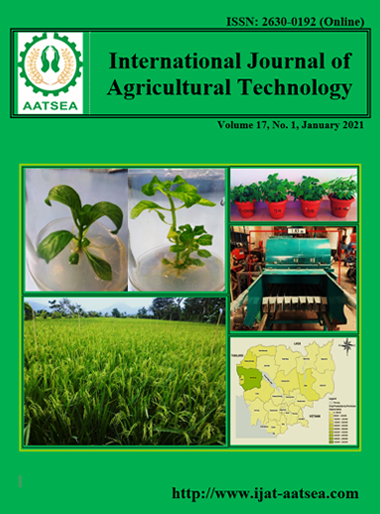Rubber agroforestry system (RAS) practices to overcome rubber price and soil erosion in Southern Thailand
Main Article Content
Abstract
Most of rubber agroforestry system (RAS) showed strategies to reduce the chemical methods. The economic margins of the 5 plots for 6-year simulation (2019-2024) were divided into 3 levels; high, medium, and low level of ability to overcome the low rubber price. Plot 1, 2 and 4 were high levels because stingless bee and bamboo in plot 1, sala in plot 2, and champadak and phakleang in plot 4 which provided more products, and the price of products were high. Especially, all these 3 plots had not spent much cost in the plots. Plot 5 was a medium level, plot 3 was low level. However, eaglewood trees in plot 3 provided very high income when age was proper for harvesting but beyond the 7-year simulation. Coffee trees in plot 5 would increase the products every year. All RAS plot practices are still an alternative to improve the livelihood of RAS farmer households. On the other hand, the plant community structure is composed of rubber trees with upper canopies and intercrops with lower canopies. When the rain come, all canopies are intercepted by absorbing the raindrops until saturated. So, the rest of raindrops would be stemflow and throughfall to the lower canopies and ground which covered by leaves and branches of rubbers and other intercrops that were fallen and decayed. These layers helped to prevent soil erosion caused by rainfall. The crown covers of all plants’ canopies in representative areas of all 5 RAS plots ranged from 93 to 98% of area that provided a great potential to protect soil from direct rainfalls in raining season and had ability to keep moisture in the plots due to the multiple levels of vertical stratification and crown covers
Article Details

This work is licensed under a Creative Commons Attribution-NonCommercial-NoDerivatives 4.0 International License.
References
Ahrends, A., Hollingsworth, P. M., Ziegler, A. D., Fox, J. M., Chen, H., Su, Y. and Xu, J. (2015). Current trends of rubber plantation expansion may threaten biodiversity and livelihoods. Global Environmental Change, 34:48-58.
Board, M. R. (2009). Rubber plantation and processing technologies. Malaysian Rubber Board. Kuala Lumpur, Malaysia.
Chen, C., Liu, W., Wu, J., Jiang, X. and Zhu, X. (2019). Can intercropping with the cash crop help improve the soil physico-chemical properties of rubber plantations? Geoderma, 335:149-160.
Fair Rubber Association (FRA) (2016). Low prices drive natural rubber producers into poverty. Retrieved from www.aidenvironment.org.
Häuser, I. (2015). Environmental and socio-economic impacts of rubber cultivation in the Mekong region: challenges for sustainable land use. CAB Reviews: Perspectives in Agriculture, Veterinary Science, Nutrition and Natural Resources 10(027). https://-doi.org/10.1079/PAVSNNR201510027.
Jongrungrot, V. (2016). Description of an agroforestry, system Asia-Pacific Journal of Science and Technology. Asia-Pacific Journal of Science and Technology, 21:46-56. Retrieved from https://www.tci-thaijo.org/index.php/APST/index.
Jongrungrot, V., Thungwa, S. and Snoeck, D. (2014). Tree-crop diversification in rubber plantations to diversify sources of income for small-scale rubber farmers in Southern Thailand. Bois et Forets Des Tropiques, 321:21-32.
Kaewwongsri, P. (2019). pramoth.k@psu.ac.th Personal interview.
Kaewwongsri, P. (2008). Princle of agroforestry. Department of Earth Science, Faculty of Natural Resources, Prince of Songkla University, Thailand.
Kittitormkool, J., Kaewwongsri, P., Tongkam, P., Bumrungsri, S. and Sawangchote, P. (2019). Livelihoods of small-scale rubber farmers: A comparative study of rubber agroforestry systems and monocropping rubber plots in Southern Thailand. Kasetsart Journal of Social Sciences, 40:420-426.
Markets Insider (2017). Global and China natural rubber industry report, 2017-2021. Retrieved from October 12, 2017 from http://markets.businessinsider.com/news/stocks-/Global-and-China-Natural-Rubber-Industry-Report-2017-2021-1002266986.
Martin, K. (2016). Effects of rubber cultivation on biodiversity in the Mekong Region SURUMER-Sustainable Rubber Cultivation in the Mekong Region View project. https://doi.org/10.1079/PAVSNNR201510044.
Praktikantin (2017a). Rubber farm economics in Thailand. Retrieved on October 12, 2017 from https://pugnatorius.com/rubber/
Research and Markets (2016). Assessment of Thailand's Rubber Industry. Retrieved on October 12, 2017 from https://www.researchandmarkets.com/research/nl9trn/assessment_of.
Ruangpanit, N. (2014). The principles of watershed management. Forestry Publications Fund, Kasetsart University, Bangkok, Thailand.
Somboonsuke, B., A., Y., Kongmanee, C. and Phitthayaphinant, P. (2019). Rubber production system and livelihood of smallholding rubber farming system (SRFS) in southern Thailand : A case study in provinces of Nakhon Si Thammarat, Phatthalung and Trang. International Journal Agricultural Technology, 15:645-664.
Somboonsuke, B., Wetayaprasit, P., Chernchom, P. and Pacheerat, K. (2011). Diversification of Smallholding Rubber Agroforestry System (SRAS) Thailand. Kasetsart Journal (Soc. Sci), 32:327-339.
Stroesser, L., Penot, E., Michel, I., Tongkaemkaew, U. and Chambon, B. (2018). Income Diversification for Rubber Farmers Through Agroforestry Practices. CRRI & IRRDB International Rubber Conference 2016, Siem Reap, Cambodia Income, 235:117.
Wangpimool, W., Pongput, K., Tangtham, N., Prachansri, S. and Gassman, P. (2016). The Impact of Para Rubber Expansion on Streamflow and Other Water Balance Components of the Nam Loei River Basin, Thailand. Water, 9(1), 1. https://doi.org/10.3390/w9010001.
Wibawa, G., Joshi, L., Noordwijk, V. and Penot, E. A. (2006). Rubber based Agroforestry Systems (RAS) as Alternatives for Rubber Monoculture System. IRRDB Annual Conference, 2006, Vietnam. Retrieved from https://halshs.archives-ouvertes.fr/halshs-00137596.
Win, H. E. (2017). Economic Importance of Rubber in Thailand. Thailand.
Zeng X. (2012). Improving planting pattern for intercropping in the whole production span of rubber tree. African Journal of Biotechnology, 11:8484-8490.


